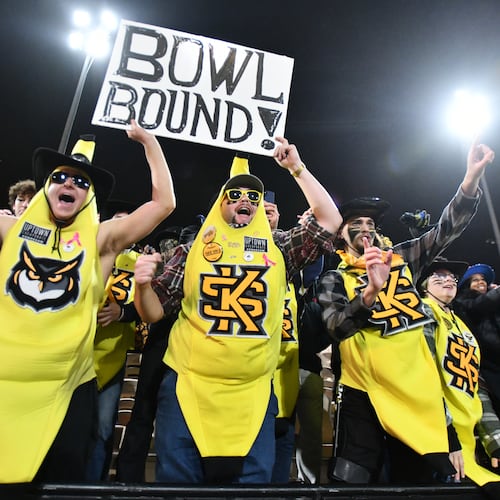When Wednesday comes for Jaylend Ratliffe, and he realizes a dream by pledging body and mind to Georgia Tech, he’ll have one more big decision to make.
Which hand to use when signing the letter of intent?
After doctors last July cut out the tea-plate-sized piece of his skull to give his injured brain room to heal, Ratliffe’s penmanship took a big hit. A lefthander, he switched to rightie to compensate for damage to his muscle control. But now he feels the dexterity in his dominant hand slowly returning.
Stubbornly, somewhat defiantly, he declares, “Oh, I’m gonna try to use my left hand.”
High schoolers across the land this week will take part in the overblown ritual during which college football reloads. Ratliffe will be unique among them all. In his case, the signing part of signing day is a victory onto itself.
Who knows if he’ll ever play a down for Tech? That pretty much depends on whether Ratliffe has used his quota of miracles after the late-July ATV accident that left him near death.
We’re not taking the usual hotshot-joins-the-fold tack here. That theme is so 10 months ago, back when the quarterback that Tech coveted while still a junior at Scotland High School committed early. Ratliffe was 210 pounds of speed and muscle, prone to default to the run when the yards were most needed. And he ran with the purpose of a starving man who was late for dinner — a perfect fit for Paul Johnson’s offense.
As he was growing into one of the best players in his state, Ratliffe never gave Tech much thought. But after visiting the campus and meeting with Johnson and Tech’s quarterback coach, Bryan Cook, he immediately was hooked.
Tech was the one school that courted him primarily as a quarterback. It was a place where the coaches seemed to say all the right things. Ratliffe was particularly impressed by one promise: We will honor our scholarship commitment to you no matter what might happen during your last season at Scotland High.
Tech was just different, a foreign urban setting for a kid whose view out his front window is nothing but flat fields. And Ratliffe is a little different sort, anyway.
“I always tell people I don’t want to be in the NFL,” he said. “I don’t want to play professional football — if I get the opportunity that’s great. I want to be a college football player, get my degree and live life like a normal person.”
Wrong turn precedes tragic crash
As last summer wore on, he was making plans to shock and awe his little eastern North Carolina town. “He was so excited about his senior year, how he was going to go off and really show out,” Ratliffe’s mother, Sharon McIntyre said.
“We began talking about another senior who got hurt and wasn’t able to play his last year,” she said. “And he said, ‘Well, nothing’s going to happen to me because I ain’t gonna do anything stupid.’ And the next day he had his accident.”
“Everything was going good,” said Richard Bailey, Scotland High’s football coach, “until that tree got in the way.”
Ratliffe remembers being bored July 29, calling a teammate and asking if he could come over and hang out. At first, they talked about staying in and playing Madden video football. Nah, someone said, let’s go ride ATVs.
As twilight gathered, a small group of four-wheelers set off to escort one of their number home. At the controls of his buddy’s bike, Ratliffe, the quarterback, went to the lead out of habit. But he took a wrong turn and got separated from the pack. Rushing to rejoin it, he hit a curve with too much speed, lost control and careened off the road and into the trees. He wasn’t wearing a helmet.
Ratliffe’s mother was on duty that evening, working the second of her two jobs as a nurse assistant at the county hospital when they brought in the second-born of her four sons. At first, nothing seemed dire. Jaylend was alert, talking, smiling but apologetic. But within a couple hours, after an MRI disclosed a skull fracture and a brain bleed, he was being airlifted to a hospital in Charlotte.
There, his injured brain began to swell and push against the confines of his skull. Ratliffe became unresponsive. “I was holding his hand; his mother was massaging his chest. Buzzers and beepers were going off. I thought he was dead,” coach Bailey said.
The only option left was to remove a portion of skull from Ratliffe’s injured right side to relieve pressure on the brain. As the patient was kept in an induced coma, his family, friends, community all kept a tense vigil. Nearly two weeks later, when it was time to rouse Ratliffe, uncertainties gathered at his bedside. What would be the extent of his brain damage? Would his left side suffer any lasting paralysis? Would his intellect be short-circuited for life? All were possibilities the doctors outlined to his mother.
Ratliffe’s memories after the accident are sketchy. Among his first recollections afterward was this: “When I woke up and realized what happened, I heard in my head coach Johnson telling me he wouldn’t let me go. I laid there and cried in my bed. I couldn’t talk, but I laid there and cried.”
Tech ‘never once wavered’
Because of NCAA regulations, no one at Tech can speak about Ratliffe’s case before he signs. They can’t comment on scholarship options, or plans for Ratliffe that could include him not starting school until 2016. Ratliffe’s doctors have told him that football is definitely out for next season, and from there they’ll evaluate.
While Ratliffe is determined to play again, it is quite possible that Tech never will realize a full return on the field from the scholarship they offered before the accident. Yet, as Bailey put it, “They never once wavered.”
“(Johnson) didn’t have to honor it,” the coach said. “It’s not like Georgia Tech has to come back to Scotland High School and recruit. You wouldn’t think there’d be as much expectation for this kind of thing as for an in-state kid.”
On signing day, it is customary to frame the recruit by his numbers on the field. Indeed, during his junior season, Ratliffe produced ample of those, rushing for more than 2,000 yards and 36 touchdowns, and throwing for another 1,800 yards and 16 touchdowns. His team eventually lost in the state championship game.
The gains he made the past season were none that would interest the dedicated recruiting wonk. As Ratliffe’s more than month-long hospital stay was nearing an end, mental-skills testing showed the depth of his injuries. In reading and math, he scored at a high elementary school level. By the end of this last semester, four months after his release, he said he brought home an A in pre-calculus.
Just last week he stood before a church youth group and retold his story as a testimony of faith.
“My biggest thing out of everything that happened, I didn’t get to tell my momma I loved her. That’s what hurt me the most. I’m lying there realizing I could just look at her, I couldn’t speak (while on a respirator). I couldn’t even tell her I loved her. All I could do was look at her and cry. That goes through my mind now. I tell her I love her every time I see her.”
And he couldn’t understand why people were crying as he spoke. Gee, wonder why?
What’s next?
The only sign today of the surgeries to first remove, then replace the sizable section of skull is a slight indentation behind Ratliffe’s right brow. If there are emotional scars, he has covered them like the hair on his head covers the physical ones.
“He’s stronger than I thought he was,” his mother said. “I thought with him not being able to play football we’d have to get him some counseling. I knew that was going to be hard for him. But he has handled that better than I thought he would.”
“I used to get frustrated and ask why me. I don’t ask that question no more. Me getting injured, I hate that it had to happen like this, but it brought our community together.” There have been a host of fundraisers to help this one-parent family deal with the medical expenses.
“I’m still a goofball,” he said. “I still play around all the time. That’s just who I’ve always been.”
The part of the brain that controlled the left side of Ratliffe’s body was the most affected by the accident. He could barely walk when he left the hospital. When he showed up for Scotland High’s home opening game, the player who once could throw the ball nearly 70 yards could not grip a football with his left hand. With regular physical therapy, Ratliffe has regained so much control of his body that he plans to run track this spring (no hurdles, the doctors have told him). There is plenty of muscle to rebuild, having lost 30 pounds throughout the ordeal. And work remains to recover strength and movement in his left hand and wrist.
Even if Ratliffe reclaims most of his physical prowess, there will remain the concerns about exposing his skull, once cracked like a dropped egg, to a season of concussive violence. Why survive the worst kind of head injury if only to stick it back into the gristmill of football?
“Speaking from a mother’s point of view, I’m not (in favor of him playing again),” McIntyre said. “At the same time, I wouldn’t ever want to stop him from doing something he loved to do. He wants to do it, so …”
“People ask me if I’m scared to play again,” Ratliffe said. “I’m not scared. If God gave me the opportunity to play again, he’s doing something with my life and nobody knows better. That’s why I don’t fear playing again.
“That’s a story to tell. That would touch so many people’s hearts: Look what God did for me. Imagine what he could do for you. ”
Let the “recruiting experts” try to rank that signing.
About the Author
Keep Reading
The Latest
Featured


